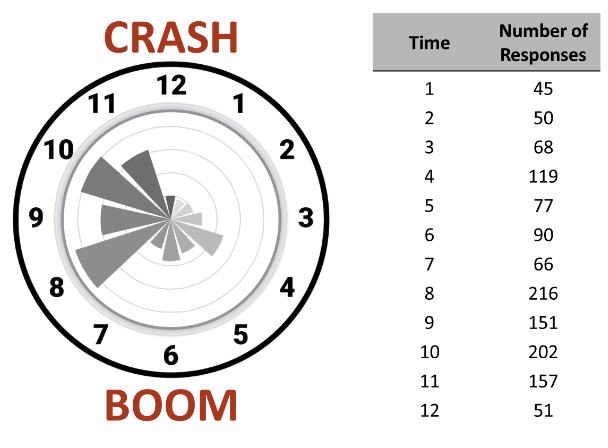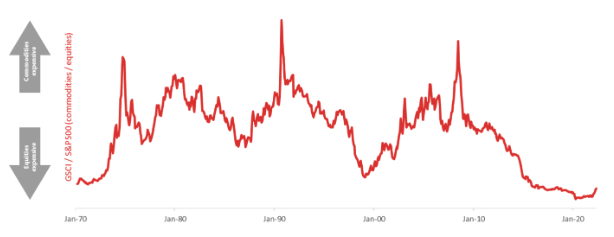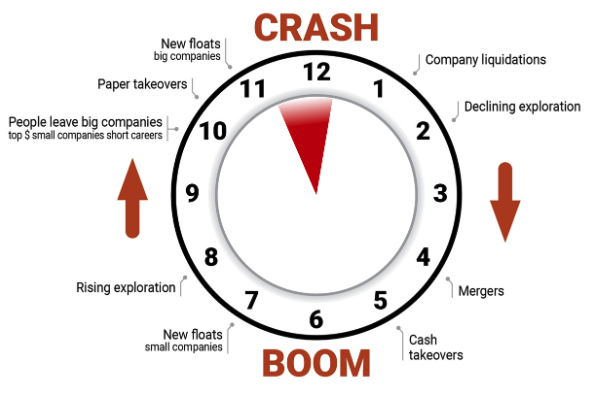Two factors will determine the fate of this mining boom
The Lion Mining Clock depicts the boom-bust cycle of the mining industry which is driven by liquidity. 2021 saw record liquidity flow into the mining sector, especially explorers – which pushed the time on the clock to 11 o’clock. In 2022, inflation burst onto the scene. It's impacting the general equity market, especially for companies trading at high multiples to low (or no) earnings.
Established miners have fared better than most so far. But liquidity has been stripped from explorers who have been sold down heavily (and come reporting season, we will see how damaging inflation has been on miners' earnings). Even so, many investors are wondering if the commodity super cycle will enable miners to defy a general market routed by inflation.
Driven by Liquidity – the Lion Clock explained
Every boom-bust cycle in mining differs from all others in detail, yet they are all identically driven by liquidity – a boom is inflated by money moving into the sector, and then busted by money flowing out, which creates very similar patterns of activity that can be mapped.
The concept of a clock closely suits this highly cyclical nature of mining. The Lion Mining Clock concept was developed by Robin Widdup while he was a mining analyst at JBWere & Son in the 1990s. It was then carried on into Lion Selection Group over the last 25 years.
Liquidity in the mining sector responds to many things. Commodity prices intersect conditions within the general equity market, as well as investor sentiment toward mining compared with other growth industries (like technology). It holds true for every investment market:
“Liquidity equals price”
To orient ourselves – a boom ends at 12 (midnight). This might not be as sudden as it was for Cinderella but can be easy to miss (or deny) until the turning point has passed.
As investors extract their money through the bust, the mining sector tightens its belt. Exploration and CAPEX budgets are reduced, and activity in the sector drops. This hurts exploration companies the most as every dollar they spend must be raised from the equity market. When investors aren’t buying shares, explorers can’t raise money.
In a bust, established miners might fall by 30% to 70% but it is not uncommon for explorers to fall by over 90%.
The boom begins at 6 o’clock, marked by equity price trends of miners switching from flat or negative to positive, which is most evident in hindsight. This turning point is often associated with an adjustment in sentiment which enables investors to begin to see value in miners. In early 2016, the major miners, BHP (ASX: BHP) and Rio Tinto (ASX: RIO) dumped their progressive dividend policies that had inflamed investors.
All of a sudden, miners were no longer financially reckless. They were cheap.
The pattern of increasing liquidity is broadly reflected in capital raisings of which the best is Initial Public Offerings (IPOs) of exploration companies. If you can’t list an explorer, then it’s not a boom, and the boom is running hot when there are lots of exploration IPOs. With increased funding, exploration activity increases and the best results feed into promotion, which enables further capital raising.
Peak liquidity conditions can embolden miners to make big deals and pay hefty premiums, which was a far clearer marker in 2008 than in many other cycles. Abundant funding that only exists during the mature stages of a boom creates conditions for large IPOs to succeed.
Large and growing population of active junior companies create an abundance of CEO positions, which results in senior managers being poached from long careers in large companies (often, to have short careers in small companies) tempted by lucrative cash and equity packages.
There is no AM or PM for this clock – it’s a 12 hour cycle!
What do Livewire readers think the time is?
The Livewire end-of-financial year reader investment intentions survey included a question about the Lion Mining Clock:
The ASX200 Resources index is up 15% in CY22 making it the best performing sector on the ASX.
What time do you think it is on the Lion Selection Resources Clock?
Responses to this question are charted and tabulated below and contain a clear acknowledgment the boom is well-progressed.
56% of respondents put the time between 8 o'clock and 11 o’clock. This goes hand in hand with strong indications of readers intending to increase exposure to commodities and gold and precious metals in the coming year.

The Timekeeper’s View - It's awfully close to 12, Cinderella
The Lion Mining Clock leads to a lot of conversations and divergent opinions. Everyone reads the signs differently, and it is very common to place all the emphasis on the outlook for commodities without considering the context of the broader equity market.
The mining cycle is a response to liquidity – which is driven by many factors, and it's necessary to encapsulate each in the judgement of the time.
Liquidity – roaring in 2021...
Austex Mining in Brisbane tracks the activity (including fundraising) of ASX mining juniors. ASX explorers raised A$9.7 billion in 2021 – more than triple the total of A$3.1 billion raised in 2016.
IPO numbers have been head-spinning: in 2021, 105 new mining (mainly exploration) classified companies were listed on the ASX, the second-highest number going back to 1995, behind 143 mining IPOs in 2007.
In 2021, the new IPOs included the listing of 29Metals (ASX: 29M), which raised $527 million – Australia’s largest Mining IPO in more than a decade. In 2022, Leo Lithium (ASX: LLL) raised A$100 million – large mining IPOs have arrived which is a key indicator of cycle maturity.
…but smashed in 2022
2022 has brought about a remarkable reversal of sentiment. Equity markets have weakened in response to surging inflation and mineral commodities have softened around the concern of a slowing Chinese economy. That hasn’t prevented miners from being among the most resilient performers in the equity market in 2022 as equity investors baulk at large premiums for companies producing low or non-existent earnings.
Suddenly it is far more challenging to raise money across the equity market. Despite the strong financial position of most established miners, explorers have already begun to feel this pain.
Liquidity in the mining sector is taking a serious hit.
And the miners' financial health? Anomalously good!
The mining sector has demonstrated amazing collective financial restraint through this boom. The main allegation toward miners in 2011 was an exceptionally poor return on investment. In self-preservation, mining CEOs have been hesitant to commit to large-scale investments this cycle and this includes M&A-style acquisitions.
Rather than reinvesting surpluses, miners have been far more generous in distributing them as dividends. In 2021, materials were the highest yielding sector in the Australian market. Miners' yield normally drops through a boom, yet instead, it has grown.
The absolute figures are actually staggering: the ASX200 index has increased in capitalisation by 2.3x between 2011 and 2021. The mining composition of the index dropped slightly (2011: 21% vs 2021: 16%) but the miners paid a whopping 46% of dividends for the whole index making this a truly unusual boom.
The fate of the boom comes down to two factors
1. Commodity Super Cycle
The notion that a commodity super cycle (driven by electrification and underinvestment) will continue to drive the mining cycle is fairly widespread. There is no doubt that commodity cycles are incredibly persistent, and electrification is a very long-term theme.
But commodity cycles (even super cycles) are prone to disruption by the general equity market. When the equity market suffers, liquidity is withdrawn across the market which affects miners and especially explorers.
Commodity super cycles are rare, brought about by major structural changes unfolding in the world economy, and typically get the most air time when mining is booming. This doesn’t discount their validity, just don’t forget that commodity markets (especially small ones) are inherently volatile and that for very good economic reasons commodity volatility often aligns with general equity market weakness.
The long-term comparison of commodities (GSCI commodity index) and equities (S&P500) as a ratio is often cited to support the argument for approaching commodity performance.

2. Inflation
Most would agree that inflation poses a huge risk to the equity market right now. It is clear and present, especially in places like the United States, where it sits at levels that haven’t been experienced since the early 1980s.
Inflation could end the era of free money and has already impinged equity markets and whacked liquidity for risky investments like explorers. Nobody knows how equity markets vs inflation will play out, but the closest templates we have from history don’t paint a rosy picture.
When US CPI pushed through high single-digit percentages in the mid-70s and early 80s, equities performed weakly.
These weren’t rapid collapses; they were material sustained falls over many months. It would seem that inflation doesn’t crash, it grinds. Each month the market awaits the latest imprint and then hangs on to commentary and actions from the central banks. Where does capitulation come from in that?
In the Vicinity of 12 o'clock
The reaction of equity markets illustrates that the weight of money is unwilling to bet against inflation. The ongoing equity market correction poses the single largest risk to the mining boom right now.

The Lion clock has shown 11 o’clock since 2021, reflective of the mature stage the cycle has reached as a result of the huge liquidity we saw during 2021. This has been exciting – it is the time when small companies are generously rewarded for their efforts and explorers can put on spectacular equity price performances.
But the impact of inflation is slowly stripping liquidity from the sector, and although this makes the assessment of time on the clock more ambiguous – it puts it in the vicinity of 12.
By our assessment, the hour hand is currently somewhere between 11.15 and 12.15.
Our outlook for miners
Established miners are in excellent collective financial health and long-term fundamentals for commodities look great, underpinned by a long period of under-investment in new supply. These provide a great outlook for miners, but for an inflation-induced liquidity crisis in the near term.
Miners are well-positioned for a rapid recovery from a mild bust. It is doubtful that the mining sector will resist the urge to invest as miners can’t escape the need to maintain production. It is easy to envisage miners capitalising on strong balance sheets to acquire juniors that have fallen in value and this would provide a clear signal of encouragement to the equity market.
Money where your mouth is?
Lion sold out of two key large and long-term holdings between mid-2021 and 2022. In June 2021 over 85% of Lion’s net tangible asset value was in two gold projects.
Pending final payment of a deferred settlement and sale of consideration shares in January 2023, Lion expects to hold in excess of A$85 million cash, which will be the majority of Lion’s NTA (over 60 cents per Lion share of cash backing).
Lion Selection Group invests in pre-production mining situations. We are little different from any miner or explorer in this regard. Lion expects to hold its exposures for years rather than months until they can be profitably realised. Whether or not Lion's holdings are listed, the ownership positions that we target are practically illiquid. If our chosen investments don’t do well, we might need to roll up our sleeves and see what we can do to help.
Circumstances coalesce around 10 or 11 o’clock making it easier to sell large percentage holdings in junior mining or exploration companies. Price is likely to be close to its highest in the cycle, and the abundance of motivated strategic buyers the greatest. So the strategy of going largely to cash absolutely suits Lion’s view of the cycle and for us, preparation has met opportunity.
What do we like?
We have a broad and actively monitored watch list focused on Australian opportunities. For now, the large cash content of our NTA will have a more certain value during a downturn than a portfolio of explorers. As the market weakens our investing universe is becoming cheaper each day and week.
We really like two commodity thematics, especially for targeting pre-production opportunities:
Gold has historically responded positively during episodes of inflation. From a project development perspective, gold is far easier to extract, transport, and sell than any other commodity and we like that risk profile in a sector that contains so much inherent uncertainty.
The key commodities in the electrification theme are providing a huge amount of new project opportunities. Lithium is moving from specialist to mainstream as a commodity that is geologically common and experiencing growing demand – we expect it to become a “bread and butter” junior sector focus. We like nickel and phosphate for similar reasons, which already have well-established product markets and electrification adds to the demand picture for both. Rare Earth Elements are distinctly more technically complex, but highly strategic. Solar panels are nowhere near as sexy as batteries but have a strong outlook as a source of renewable energy, which positions silver strongly. And it is really hard to go past the old world, but new again, metals copper and tin.
About Lion
Lion Selection Group is listed on ASX under the ticker LSX. As of 31 May 2022, Lion’s after-tax NTA was 68.2cps, and Lion’s shares closed at 44.5cps on 28 June 2022. Visit our website for more information.
3 topics
5 stocks mentioned

